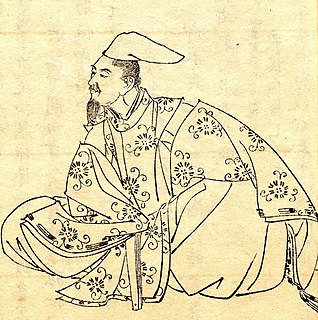It has been suggested that this article be merged into Chokusen wakashū . (Discuss) Proposed since January 2018. |
The Nijūichidaishū(二十一代集Collections of the Twenty-One Eras) are Japan's twenty one imperial collections (chokusenshū) of waka poetry written by noblemen. The following texts listed in chronological order constitute the Nijūichidaishū:

Japan is an island country in East Asia. Located in the Pacific Ocean, it lies off the eastern coast of the Asian continent and stretches from the Sea of Okhotsk in the north to the East China Sea and the Philippine Sea in the south.

Waka is a type of poetry in classical Japanese literature. Waka are composed in Japanese, and are contrasted with poetry composed by Japanese poets in Classical Chinese, which are known as kanshi. Although waka in modern Japanese is written as 和歌, in the past it was also written as 倭歌, and a variant name is yamato-uta (大和歌).
The Hachidaishū are the first eight collections, in which the first three collections are the Sandaishū . The Sandaishū provided both the language and organizational principles for the rest of the anthologies thereafter. They are:
The Hachidaishū (八代集) are the first eight imperial anthologies of Japanese waka poetry, of which the first three collections are the Sandaishū. The Sandaishū provided both the language and organizational principles for the rest of the anthologies thereafter. They are:
The Sandaishū (三代集) are the first three imperial anthologies of Japanese waka poetry. The Sandaishū provided both the language and organizational principles for the rest of the anthologies thereafter. They are:
- Kokin Wakashū
- Gosen Wakashū
- Shūi Wakashū
- Goshūi Wakashū
- Kin'yō Wakashū
- Shika Wakashū
- Senzai Wakashū
- Shin Kokin Wakashū

The Kokin Wakashū, commonly abbreviated as Kokinshū (古今集), is an early anthology of the waka form of Japanese poetry, dating from the Heian period. It is an Imperial anthology, conceived of by Emperor Uda and published by order of his son Emperor Daigo, in about 905. Its finished form dates to c. 920, though according to several historical accounts the last poem was added to the collection in 914. The compilers of the anthology were four court poets, led by Ki no Tsurayuki and also including Ki no Tomonori, Ōshikōchi no Mitsune, and Mibu no Tadamine.

The Gosen Wakashū, often abbreviated as Gosenshū, is an imperial anthology of Japanese waka compiled in 951 at the behest of Emperor Murakami by the Five Men of the Pear Chamber: Ōnakatomi no Yoshinobu (922-991), Kiyohara no Motosuke (908-990), Minamoto no Shitagō (911-983), Ki no Tokibumi, and Sakanoue no Mochiki. It consists of twenty volumes containing 1,426 poems.

The Shūi Wakashū, often abbreviated as Shūishū, is the third imperial anthology of waka from Heian period Japan. It was compiled by Emperor Kazan in about 1005. Its twenty volumes contain 1,351 poems. The details of its publication and compilation are unclear.
The Jūsandaishū are the later thirteen collections. They are:
The Jūsandaishū (十三代集) are the last thirteen imperial anthologies of Japanese waka poetry. They are:
- Shinchokusen Wakashū
- Shokugosen Wakashū
- Shokukokin Wakashū
- Shokushūi Wakashū
- Shingosen Wakashū
- Gyokuyō Wakashū
- Shokusenzai Wakashū
- Shokugoshūi Wakashū
- Fūga Wakashū
- Shinsenzai Wakashū
- Shinshūi Wakashū
- Shingoshūi Wakashū
- Shinshokukokin Wakashū
Shinchokusen Wakashū, abbreviated as Shinchokusenshū, is an imperial anthology of Japanese waka, initially compiled in ~1234 CE at the behest of the Retired Emperor Go-Horikawa. It was compiled by Fujiwara no Teika. It consists of twenty volumes containing 1,376 poems. Miner and Brower remark that "The collection reflects Teika's late preference for poetry of a relatively plain, simple style." This sentiment accurately reflects its conservative selection, taking 47 poems from Fujiwara no Ietaka, 36 from Fujiwara no Yoshitsune, a full 35 from Fujiwara no Shunzei, along with 30 by Saionji Kintsune and 27 from the priest Jakuren.
The Shokugosen Wakashū (続後撰和歌集) was an imperial anthology of Japanese waka poetry. It was finished in 1251 CE, three years after the Retired Emperor Go-Saga first ordered it in 1248. It was compiled by Fujiwara no Tameie, son of Fujiwara no Teika. It consists of twenty volumes containing 1,368 poems. It is characterized by the conservative taste and general competency of the Nijō faction that would be founded by Tameie's son.
The Shokukokin Wakashū is a Japanese imperial anthology of waka; it was finished in 1265 CE, six years after the Retired Emperor Go-Saga first ordered it in 1259. It was compiled by Fujiwara no Tameie with the aid of Fujiwara no Motoie, Fujiwara no Ieyoshi, Fujiwara no Yukiee, and Fujiwara no Mitsutoshi; like most Imperial anthologies, there is a Japanese and a Chinese Preface, but their authorship is obscure and essentially unknown. It consists of twenty volumes containing 1,925 poems.
Note that the Shin'yō Wakashū —although an imperial anthology of Japanese poetry—is not included in the list of twenty one collections.
The Waka Collection of New Leaves is a Nanboku-chō period collection of Japanese poetry compiled by Munenaga Shinnō ca. 1381. Although commissioned by Emperor Chōkei of the Southern Court, it is not included in the Nijūichidaishū, i.e., the twenty-one imperial anthologies for political reasons – the "official" anthologies had been sponsored by the rival Northern Court and the Ashikaga shōguns.


